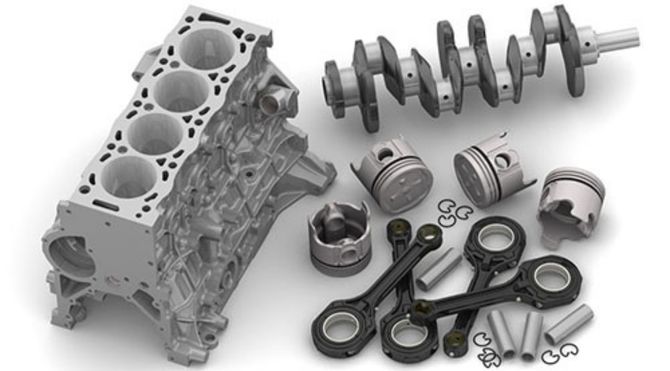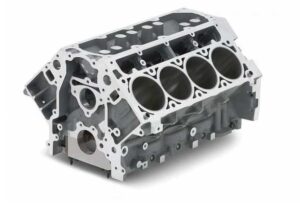
the engine is the heart of a car it is a complex machine built to convert the heat from the combustion air fuel mixture into the forces that turn the wheels on the road it consists of two main parts the heavy part is at the bottom the cylinder block which is the home of the main moving parts of the engine the cylindrical block supports the pistons the piston crankshaft connecting rod and the oil pan is removable on the top The cylindrical head supports the camshaft cam, enables the intake and exhaust valves to open and close as air and fuel mixture enters the combustion chamber, where the main parts that make up an engine block are:

Engine Block, Piston and Combustion Chamber :
The engine block is the main support structure of the engine where combustion takes place. The engine block is mostly made by casting as a single unit using cast iron and aluminum alloys. The piston is the heart of the engine Pistons are most often made by casting or forging cast iron or aluminum alloys that are strong enough to withstand the high temperatures and pressures created by combustion in most automobile engines the explosive force of the air fuel mixture drives the piston the pistons rotate the crankshaft on which they are mounted the torque of the crankshaft causes the wheels of the car to turn is the combustion chamber the combustion chamber is the area inside the cylinder the highest position the piston reaches within the cylinder is called top dead center and the lowest position during a compression stroke is called bottom dead center. The piston moves from bottom dead center to top dead center, this increases the pressure and temperature of the air fuel mixture when the piston reaches top dead center. The spark plug in the center ignites the mixture and produces energy.

Connecting Rod, Crankshaft and Timing Belt :
Connecting rods are connecting rods usually made of forged steel used to connect the pistons to the crankshaft to transmit the reciprocating motion the crankshaft is internally supported by the engine block the combustion of fuel due to the reciprocating motion of the piston is transmitted through the connecting rod to the rotational motion of the crankshaft which is then it drives the timing belt of the wheels the belt is a heavy duty rubber with gears to grip the pulleys from the crankshaft and camshaft the camshaft and crankshaft are synchronized it ensures the correct timing to keep the engine running smoothly.

Oil Pan, Flywheel, Cam and Camshaft :
The oil pan is mainly used to collect lubricating oil. All engine parts must be lubricated to reduce the friction between them to ensure smooth operation of all parts. The speed and torque of a car engine are not uniform, fluctuation affects the life of other parts. To prevent this, the flywheel is used. The flywheel is mounted on the crankshaft to balance the speed of the vehicle. The cam and camshaft cam is an egg-shaped round steel plate that is attached to the camshaft. The main function of the cam is to control the timing of the intake and exhaust valves. The seal is an important engine part that ensures air tightness and ensures no leaks or losses between the engine block and the cylinder head.

Gasket and Spark Plug :
Cylinder head spark plug with manifold and exhaust manifold The spark plug has a metal threaded shell that is electrically isolated from a central electrode by a ceramic insulator during the compression stroke when the piston reaches top dead center. An electric spark produced by the spark plug is used to ignite the compressed air fuel mixture.

Leave a Reply